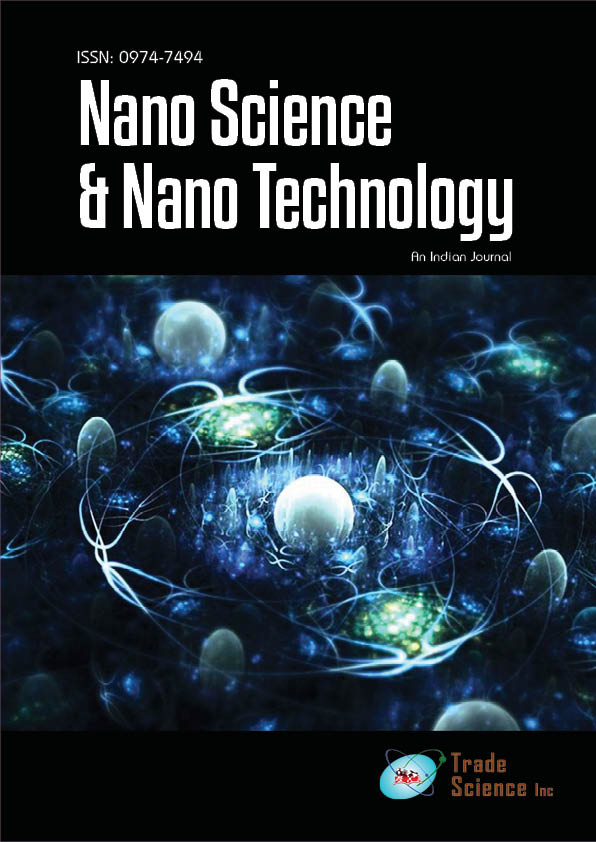Perspective
, Volume: 16( 5) DOI: doi: 10.37532/ 0974-7494.2022.16(5).164An analysis of the structure of carbon nanotubes
Jennifer Stewart*
Editorial Office, Nanoscience & Nanotechnology: An Indian Journal, UK
- *Correspondence:
- Jennifer Stewart Editorial office, Nanoscience & Nanotechnology: An Indian Journal, UK, E-mail: stewart_56@rediff.co.in
Received: Sep 2, 2022, Manuscript No tsnsnt-22-81667; Editor assigned: Sep 4, 2022, PreQC No. tsnsnt-22-81667 (PQ); Reviewed: Sep 16, 2022, QC No tsnsnt-22-81667 (Q); Revised: Sep 19, 2022, Manuscript No tsnsnt-22-81667 (R); Published: Sep 30, 2022, doi: 10.37532/ 0974-7494.2022.16(5).164
Citation: Stewart J. An Analysis of the Structure of Carbon Nanotubes. Nano Tech Nano Sci Ind J. 2022; 16(5):164.
Abstract
Allotropes of carbon with a length-to-diameter ratio greater than one million are known as carbon nanotubes (CNTs). Arc discharge, laser ablation, and chemical vapour deposition are a few of the methods that have been developed to produce nanotubes in large quantities. Recent developments have shown the revolutionary potential of nanoparticles, particularly in the fields of biomedical imaging, drug delivery, bio sensing, and the creation of useful nanocomposites. To effectively interface proteins with nanomaterials for these applications, new techniques are constantly being developed.
Introduction
Allotropes of carbon with a length-to-diameter ratio greater than one million are known as Carbon Nanotubes (CNTs). Arc discharge, laser ablation, and chemical vapour deposition are a few of the methods that have been developed to produce nanotubes in large quantities. Recent developments have shown the revolutionary potential of nanoparticles, particularly in the fields of biomedical imaging, drug delivery, bio sensing, and the creation of useful nanocomposites. To effectively interface proteins with nanomaterials for these applications, new techniques are constantly being developed. The concentration of the immobilized entity was significantly higher than that of other materials because nanoparticles have a high surface-to-volume ratio. The study of how nanomaterials impact the composition and behaviour of proteins is also gaining popularity. In nature, pure carbon can be found in two different crystalline forms: diamond and graphite.
When four bonds are oriented toward the corners of a regular tetrahedron, hybridization takes place, as seen in the carbon atoms of diamonds. The resulting three-dimensional network (diamond), which is incredibly stiff, is one factor contributing to the material's hardness. Graphite, which has a weak bond along its axis and each atom is uniformly bonded to three carbon atoms in a plane at a temperature of 120°C, is a material where hybridization occurs. In graphite sheets, the set produces the hexagonal (honeycomb) lattice. The discovery of Buckminsterfullerene, a brand-new form of carbon, was made in 1985 by a group led by Korto and collaborators. In addition to diamond, graphite, and fullerene, Ijima discovered the quasi-one-dimensional nanotube in carbon soot made through an arc-discharge process in 1991. The carbon allotrope carbon nanotubes (CNTs) are. The tubes that make up CNTs are made of graphite. The outer diameters of the tubes, which ranged from 3 nm to 5 nm, were at least two and frequently many more layers thick. Carbon nanotubes with a single wall were discovered two years later. The same process as MWCNTs was used by Dresselhaus et al. to create single-walled carbon nanotubes, but the carbon electrodes also contained transition metal particles. The widths of single-walled nanotubes, which range from 0.1 to 2 nm and have a curved rather than a straight shape, are typically smaller than those of multi-walled tubes. In the past ten years, a lot of research has been done on the structural, electrical, mechanical, electromechanical, and chemical characteristics of carbon nanotubes. The focus of a recent study was on enhanced catalytically generated nanotube quality
Properties
Given the strength of their carbon-carbon bonds, carbon nanotubes have extraordinary mechanical properties. The superior mechanical, thermal, and electrical properties that they possess have never been demonstrated by any other material. It is possible for them to have densities as low as 1.3 grammes per cubic centimeter. More than 1TPa, or about 5 times higher than steel, is the Young's modulus of CNTs, which makes them stronger than all carbon fibers. Contrarily, what sets them apart is their strength. The most potent substance that people have ever discovered is carbon nanotubes. Up to 63 GPa, or about 50 times stronger than steel, was the maximum measured tensile strength or breaking strain of a carbon nanotube. Even the most fragile types of carbon nanotubes have strengths of many GPa
Cleaning of carbon nanotube
The aforementioned methods inevitably produce carbonaceous contaminants and metal catalyst particles in the as synthesized CNTs, and the amount of impurities frequently increases as CNT diameter lowers. The two primary problems that still need to be solved are how to get rid of impurities such amorphous carbons and metallic catalysts and make homogenous carbon nanotube dispersions in dispersing medium or polymer solutions. Impurities seriously degrade the electrical and mechanical properties of unpurified carbon nanotubes. As CNTs soot is produced, impurities are abundant. All of the production techniques that are currently accessible result in contaminated CNTs.Since the discovery of carbon nanotubes, purification has occupied a large portion of synthetic research.
Conclusion
Several altered synthesis processes have been developed to produce CNTs on a large scale for commercial use. Due to its low cost in comparison to other methods, the CVD approach currently offers the best chance of producing a significant amount of CNTs. Due to the high cost of manufacturing the highest quality nanotubes, commercial applications for carbon nanotubes have been slow to develop. Carbon nanotube chemistry has made significant progress, and this area will lead to new uses for the material. The functionalization of CNTs, especially those with specific length, diameter, and chirality, will enhance the molecular control of CNT-based materials and devices. It is shown in the current article that their enormous potential for biotechnology and biomedicine is only now being realized. A wide range of applications are possible because different biomolecules can interact and immobilize on CNTs. The best method of immobilization may differ depending on the enzyme, application, and carrier since there is no standard enzyme support. The fascinating properties of CNTs and physical/chemical techniques should be combined in the future to create an immobilized enzyme with even greater stability and catalytic activity. This data from protein sequences, 3D architectures, and reaction mechanisms should be integrated. Using non-covalent techniques to immobilize enzymes reduces their degree of denouement while preserving CNTs' inherent electronic structure and properties.

